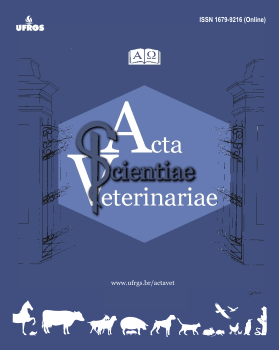Angiolipoma in a Dog
DOI:
https://doi.org/10.22456/1679-9216.106584Abstract
Background: Angiolipoma is a benign tumor composed of endothelial cells and mature adipocytes. Tumors reported in domestic species include two variants; infiltrative or non-infiltrative. Bitches and intact males seem predisposed. This mesenchyme tumor is commonly mistaken with lipoma due to its soft texture and subcutaneous site and often requires histopathology to confirm its diagnosis. Microscopic examination also enables the evaluation of surgical margins and rule out possible infiltrative sites. Complete surgical excision is usually curative. This study reports a case of non-infiltrating angiolipoma in a dog.
Case: A 14-year-old mixed-breed dog was presented to a veterinary clinic in the city of Rio de Janeiro, RJ, Brazil. On palpation, a painless mass was noted, with high mobility and covered by intact hirsute skin in the right subcutaneous ventrolateral region. Computed tomography of the chest showed an expansive mass of uptake only from the edges of the soft tissues of the right subcutaneous ventrolateral region. The mass was homogeneous and well delimited, suggesting a neoplastic process. Subsequently, the mass was surgically removed, fixed in 10% buffered formalin, and sent for histopathological analysis. On macroscopic examination, the mass was well delimited, without skin coverage, and measured 2.3 × 1.9 × 0.6 cm. The consistency was smooth and unctuous in appearance with a compact cream-colored surface with blackish multifocal spots. Under microscopy, the histological sections showed neoplasm of mature adipocytes and of endothelial cells of blood vessels benign were filled with a marked amount of red blood cells. Multifocal fibrin thrombi and a mild inflammatory infiltrate composed of lymphocytes and rare mast cells were evident. There was no infiltration in the regional skeletal musculature. Thus, a diagnosis of non-infiltrative angiolipoma was established.
Discussion: The diagnosis of non-infiltrating angiolipoma in this case was established through the results of histopathological examination. The occurrence of this neoplasm in dogs is uncommon, and the data reported in the veterinary medicine literature are scarce. However, in this study, it was found that the neoplasm on screening presented a behavior like that of lipomas, with noninvasive growth and the absence of local recurrence. The canine species does not commonly convey pain on palpation during a clinical examination, as observed in the present case. In humans, multiple angiolipoma nodules are common; this clinical presentation differs from that in animals, in which solitary nodules are generally observed. In dogs, as in the present case, they seem to have a predilection for the trunk. In animals, the pathogenesis of angiolipomas is not established, but in humans, it is based on theories that include the reaction to harmful stimuli and congenital malformation of adipose tissue. In humans, the presence of fibrin thrombi on the periphery of the region of cell proliferation are microscopic findings that can assist in the diagnosis of angiolipomas, an approach that was implemented in the present case. The occurrence of this neoplasm in dogs is uncommon, and the data reported in the veterinary medicine literature are scarce. The importance of an adequate description of angiolipomas is based on the need to provide information about its epidemiology, biological behavior, and prognosis.
Downloads
References
Apostolakis S., Karagianni A., Mitropoulos A., Mantas C., Mavridis L., Filias P., Eftychiadis C. & Vlachos K. 2020. Spinal angiolipoma: Presentation of two cases and review of the literature for the years 2012-2017. Neurocirugía. 31: 76-86. DOI: doi.org/10.1016/j.neucir.2019.04.005
Goldblum J., Weiss S. & Folpe A.L. 2013. Benign lipomatous tumors. In: Enzinger F.M. & Weiss S.W. (Eds). Soft Tissue Tumours. 6th edn. Philadelphia: Elsevier Saunders, pp.449-452.
Gross T.L., Ihrke P.J., Walder E.J. & Affolter V.K. 2009. Tumores lipocíticos. In: Gross T.L., Ihrke P.J., Walder E.J. & Affolter V.K. (Eds). Doenças de pele do cão e do gato: diagnóstico clínico e histopatológico. 2.ed. São Paulo: Roca, pp.750-761.
Hamano A., Suzuki K., Saito T., Kuwatsuru R., Oh S. & Suzuki K. 2013. Infiltrating angiolipoma of the thoracic wall: a case report. Open Journal of Clinical Diagnostics. 3:19-22. DOI: 10.4236/ojcd.2013.32005
Kitshoff A.M., MIllward I.R., Williams J.H., Cliftb S.J. & Kirbergerc R.M. 2010. Infiltrative angiolipoma of the parotid salivary gland in a dog. Journal of the South African Veterinary Association. 81:258-261. DOI: 10.4102/jsava.v81i4.158
Kraun M.B., Nelson N.C. & Hollinger C. 2015. Imaging diagnosis-computed tomographic, surgical, and histopathologic characteristics of an infiltrative angiolipoma in a dog. Veterinary Radiology Ultrasound. 56: 31-35. DOI: 10.1111/vru.12178
Liggett A.D., Frazier K.S. & Styer E.L. 2002. Angiolipomatous tumors in dogs and a cat. Veterinary Pathology. 39: 286-289. DOI: doi.org/10.1354/vp.39-2-286
Lou X.H., Chen W.G., Ning L.G., Chen H.T. & Xu G.Q. 2019. Multiple gastric angiolipomas: A case report. World Journal of Clinical Cases. 7: 778-784. DOI: 10.12998/wjcc.v7.i6.778
Reif U., Lowrie C.T. & Fitzgerald S.D. 1998. Extradural spinal angiolipoma associated with bone lysis in a dog. Journal of the American Animal Hospital Association. 34: 373-376. DOI: 10.5326/15473317-34-5-373
Swamy M., Chandrapuria V.P. & Kumar K. 2004. Angiolipoma in a dog. Indian Journal of Veterinary Pathology. 28: 141. DOI: 10.1354/vp.39-2-286
Published
How to Cite
Issue
Section
License
This journal provides open access to all of its content on the principle that making research freely available to the public supports a greater global exchange of knowledge. Such access is associated with increased readership and increased citation of an author's work. For more information on this approach, see the Public Knowledge Project and Directory of Open Access Journals.
We define open access journals as journals that use a funding model that does not charge readers or their institutions for access. From the BOAI definition of "open access" we take the right of users to "read, download, copy, distribute, print, search, or link to the full texts of these articles" as mandatory for a journal to be included in the directory.
La Red y Portal Iberoamericano de Revistas Científicas de Veterinaria de Libre Acceso reúne a las principales publicaciones científicas editadas en España, Portugal, Latino América y otros países del ámbito latino





